MKT1MDP: Analysis of Australian Sugar Confectionery Industry
VerifiedAdded on 2022/11/29
|5
|1103
|405
Report
AI Summary
This report provides a detailed analysis of the Australian sugar confectionery industry, examining its macro-environmental factors, including economic, political, legal, sociocultural, and environmental influences. It explores the challenges posed by changing consumer needs, such as the growing concern over obesity and the potential impact of sugar taxes. The report then delves into the market segmentation of the industry, analyzing the roles of retailers, wholesalers, food manufacturers, export markets, and food-service establishments. It highlights the increasing market share of retailers and the growing importance of the export market. The conclusion and recommendations emphasize the need for the industry to adapt to changing consumer preferences by reducing sugar content and developing healthier product alternatives. The report also acknowledges the strong market share held by major brands like Cadbury Schweppes and Nestlé Confectionery, while also discussing the political and legal risks associated with international markets.
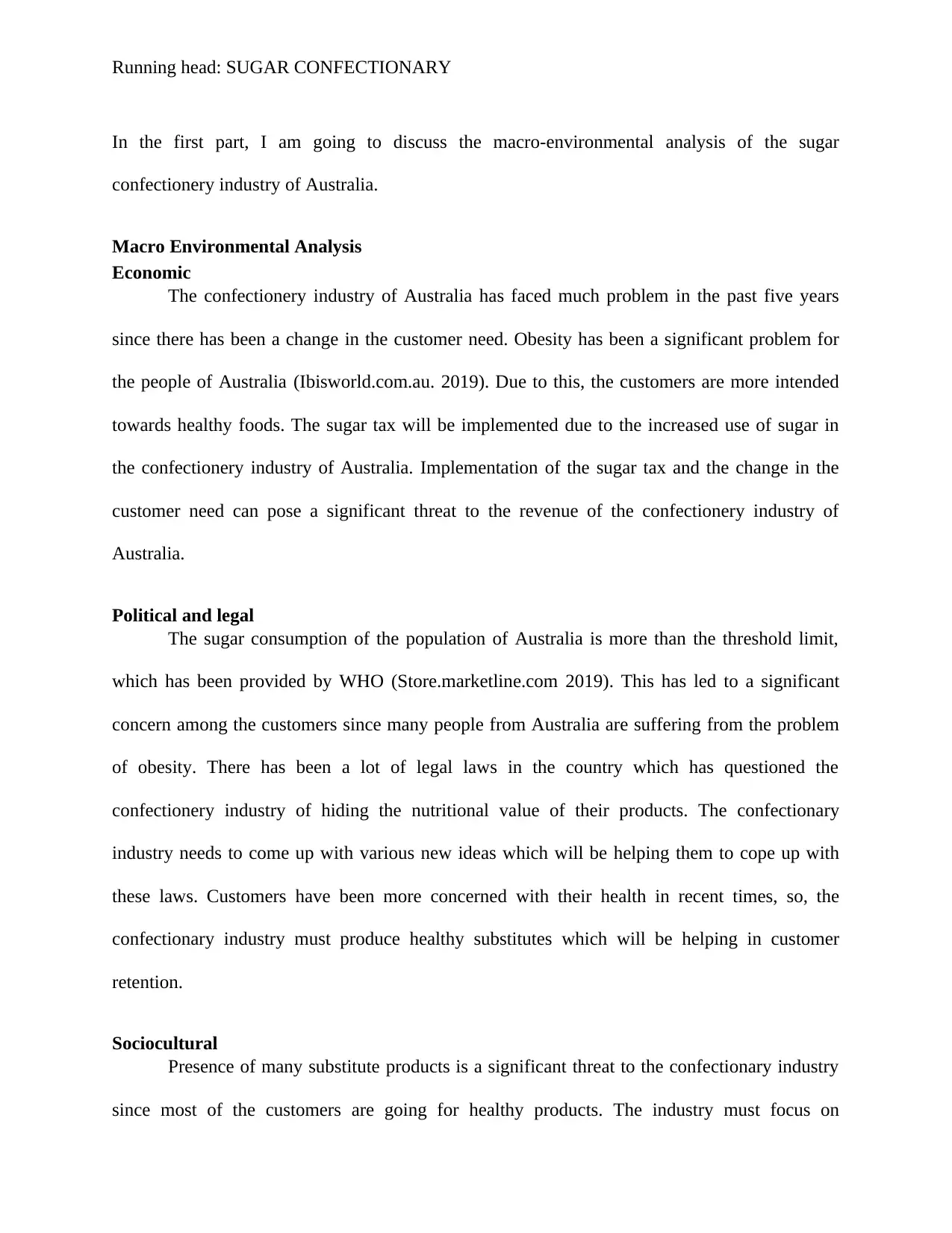
Running head: SUGAR CONFECTIONARY
In the first part, I am going to discuss the macro-environmental analysis of the sugar
confectionery industry of Australia.
Macro Environmental Analysis
Economic
The confectionery industry of Australia has faced much problem in the past five years
since there has been a change in the customer need. Obesity has been a significant problem for
the people of Australia (Ibisworld.com.au. 2019). Due to this, the customers are more intended
towards healthy foods. The sugar tax will be implemented due to the increased use of sugar in
the confectionery industry of Australia. Implementation of the sugar tax and the change in the
customer need can pose a significant threat to the revenue of the confectionery industry of
Australia.
Political and legal
The sugar consumption of the population of Australia is more than the threshold limit,
which has been provided by WHO (Store.marketline.com 2019). This has led to a significant
concern among the customers since many people from Australia are suffering from the problem
of obesity. There has been a lot of legal laws in the country which has questioned the
confectionery industry of hiding the nutritional value of their products. The confectionary
industry needs to come up with various new ideas which will be helping them to cope up with
these laws. Customers have been more concerned with their health in recent times, so, the
confectionary industry must produce healthy substitutes which will be helping in customer
retention.
Sociocultural
Presence of many substitute products is a significant threat to the confectionary industry
since most of the customers are going for healthy products. The industry must focus on
In the first part, I am going to discuss the macro-environmental analysis of the sugar
confectionery industry of Australia.
Macro Environmental Analysis
Economic
The confectionery industry of Australia has faced much problem in the past five years
since there has been a change in the customer need. Obesity has been a significant problem for
the people of Australia (Ibisworld.com.au. 2019). Due to this, the customers are more intended
towards healthy foods. The sugar tax will be implemented due to the increased use of sugar in
the confectionery industry of Australia. Implementation of the sugar tax and the change in the
customer need can pose a significant threat to the revenue of the confectionery industry of
Australia.
Political and legal
The sugar consumption of the population of Australia is more than the threshold limit,
which has been provided by WHO (Store.marketline.com 2019). This has led to a significant
concern among the customers since many people from Australia are suffering from the problem
of obesity. There has been a lot of legal laws in the country which has questioned the
confectionery industry of hiding the nutritional value of their products. The confectionary
industry needs to come up with various new ideas which will be helping them to cope up with
these laws. Customers have been more concerned with their health in recent times, so, the
confectionary industry must produce healthy substitutes which will be helping in customer
retention.
Sociocultural
Presence of many substitute products is a significant threat to the confectionary industry
since most of the customers are going for healthy products. The industry must focus on
Paraphrase This Document
Need a fresh take? Get an instant paraphrase of this document with our AI Paraphraser
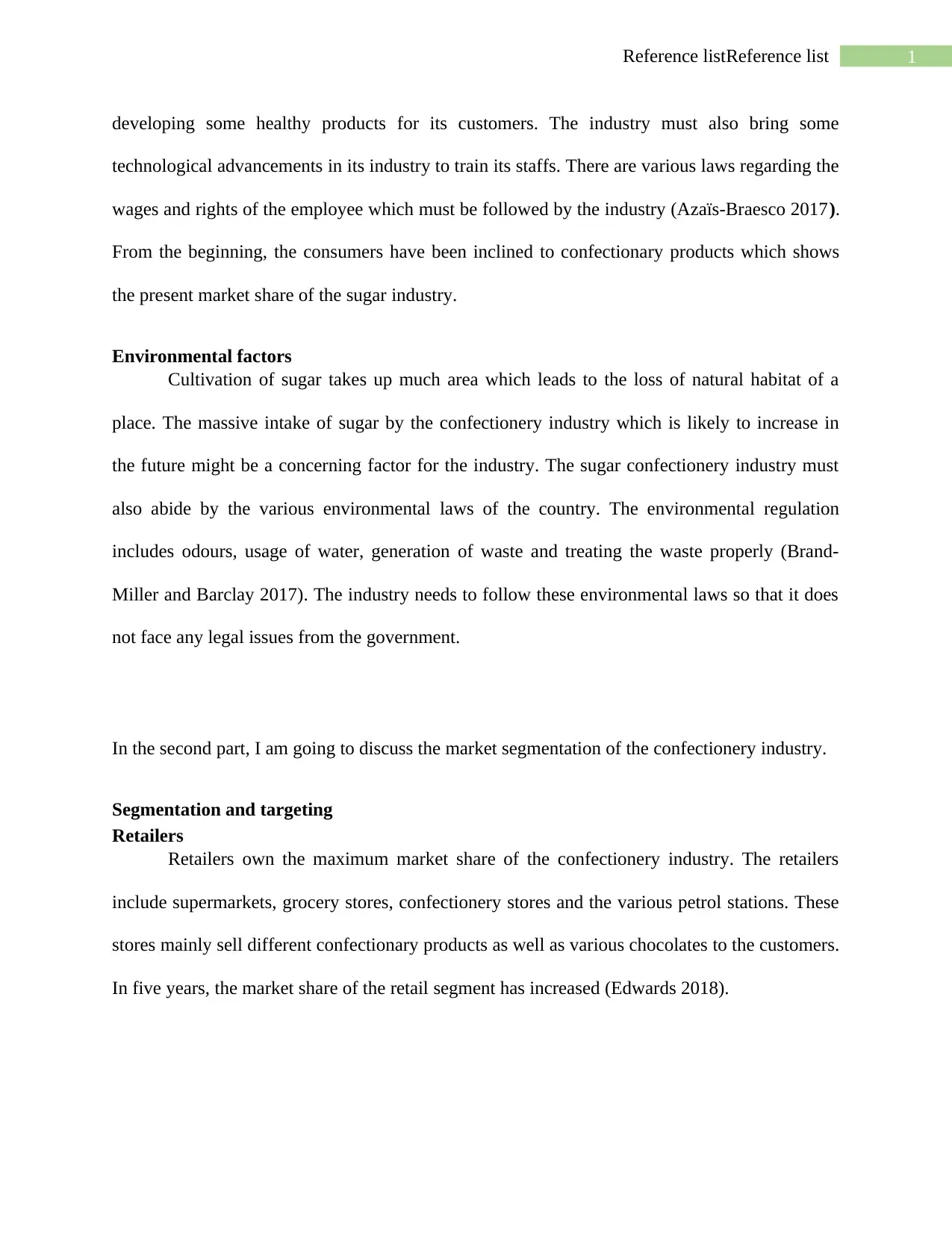
1Reference listReference list
developing some healthy products for its customers. The industry must also bring some
technological advancements in its industry to train its staffs. There are various laws regarding the
wages and rights of the employee which must be followed by the industry (Azaïs-Braesco 2017).
From the beginning, the consumers have been inclined to confectionary products which shows
the present market share of the sugar industry.
Environmental factors
Cultivation of sugar takes up much area which leads to the loss of natural habitat of a
place. The massive intake of sugar by the confectionery industry which is likely to increase in
the future might be a concerning factor for the industry. The sugar confectionery industry must
also abide by the various environmental laws of the country. The environmental regulation
includes odours, usage of water, generation of waste and treating the waste properly (Brand-
Miller and Barclay 2017). The industry needs to follow these environmental laws so that it does
not face any legal issues from the government.
In the second part, I am going to discuss the market segmentation of the confectionery industry.
Segmentation and targeting
Retailers
Retailers own the maximum market share of the confectionery industry. The retailers
include supermarkets, grocery stores, confectionery stores and the various petrol stations. These
stores mainly sell different confectionary products as well as various chocolates to the customers.
In five years, the market share of the retail segment has increased (Edwards 2018).
developing some healthy products for its customers. The industry must also bring some
technological advancements in its industry to train its staffs. There are various laws regarding the
wages and rights of the employee which must be followed by the industry (Azaïs-Braesco 2017).
From the beginning, the consumers have been inclined to confectionary products which shows
the present market share of the sugar industry.
Environmental factors
Cultivation of sugar takes up much area which leads to the loss of natural habitat of a
place. The massive intake of sugar by the confectionery industry which is likely to increase in
the future might be a concerning factor for the industry. The sugar confectionery industry must
also abide by the various environmental laws of the country. The environmental regulation
includes odours, usage of water, generation of waste and treating the waste properly (Brand-
Miller and Barclay 2017). The industry needs to follow these environmental laws so that it does
not face any legal issues from the government.
In the second part, I am going to discuss the market segmentation of the confectionery industry.
Segmentation and targeting
Retailers
Retailers own the maximum market share of the confectionery industry. The retailers
include supermarkets, grocery stores, confectionery stores and the various petrol stations. These
stores mainly sell different confectionary products as well as various chocolates to the customers.
In five years, the market share of the retail segment has increased (Edwards 2018).
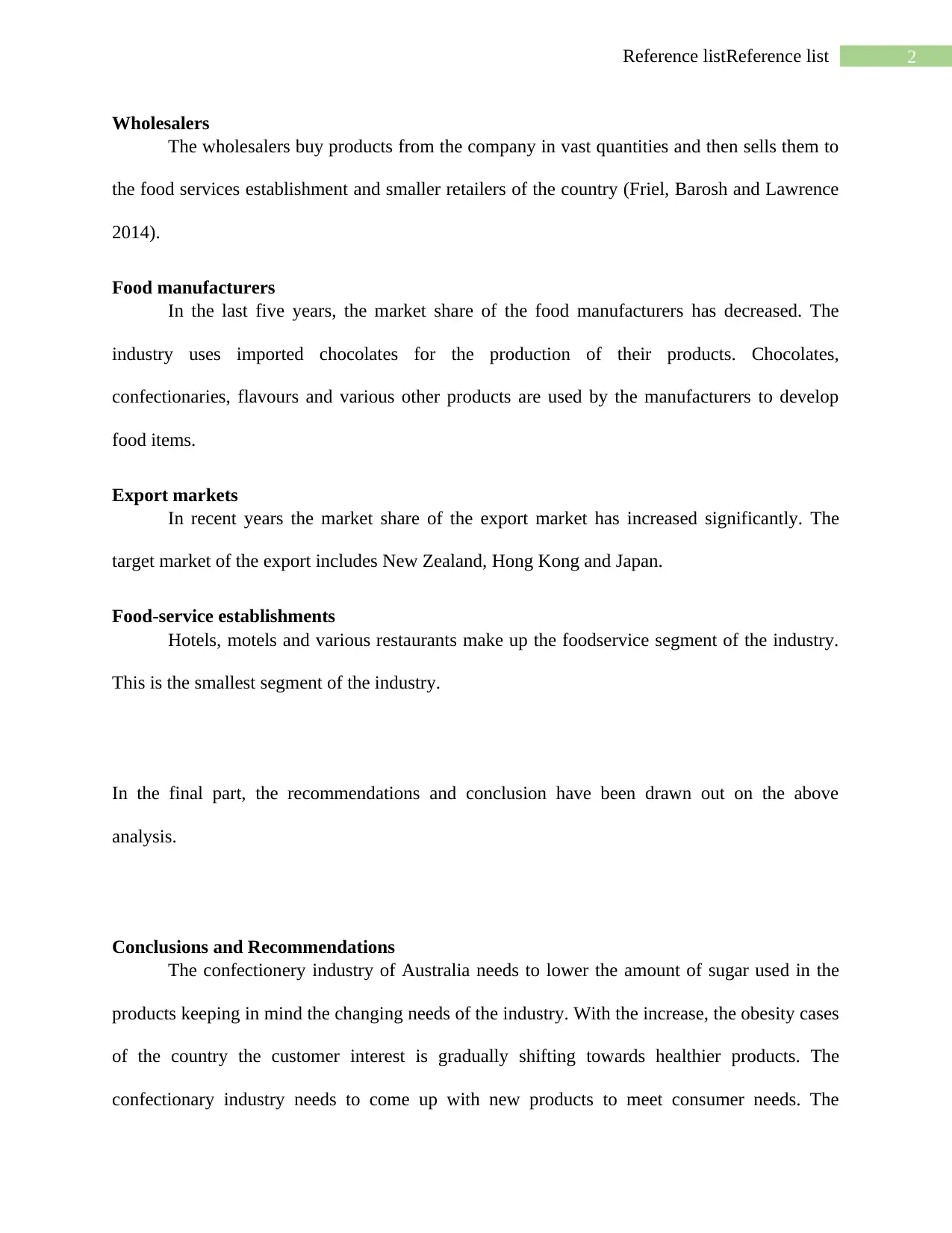
2Reference listReference list
Wholesalers
The wholesalers buy products from the company in vast quantities and then sells them to
the food services establishment and smaller retailers of the country (Friel, Barosh and Lawrence
2014).
Food manufacturers
In the last five years, the market share of the food manufacturers has decreased. The
industry uses imported chocolates for the production of their products. Chocolates,
confectionaries, flavours and various other products are used by the manufacturers to develop
food items.
Export markets
In recent years the market share of the export market has increased significantly. The
target market of the export includes New Zealand, Hong Kong and Japan.
Food-service establishments
Hotels, motels and various restaurants make up the foodservice segment of the industry.
This is the smallest segment of the industry.
In the final part, the recommendations and conclusion have been drawn out on the above
analysis.
Conclusions and Recommendations
The confectionery industry of Australia needs to lower the amount of sugar used in the
products keeping in mind the changing needs of the industry. With the increase, the obesity cases
of the country the customer interest is gradually shifting towards healthier products. The
confectionary industry needs to come up with new products to meet consumer needs. The
Wholesalers
The wholesalers buy products from the company in vast quantities and then sells them to
the food services establishment and smaller retailers of the country (Friel, Barosh and Lawrence
2014).
Food manufacturers
In the last five years, the market share of the food manufacturers has decreased. The
industry uses imported chocolates for the production of their products. Chocolates,
confectionaries, flavours and various other products are used by the manufacturers to develop
food items.
Export markets
In recent years the market share of the export market has increased significantly. The
target market of the export includes New Zealand, Hong Kong and Japan.
Food-service establishments
Hotels, motels and various restaurants make up the foodservice segment of the industry.
This is the smallest segment of the industry.
In the final part, the recommendations and conclusion have been drawn out on the above
analysis.
Conclusions and Recommendations
The confectionery industry of Australia needs to lower the amount of sugar used in the
products keeping in mind the changing needs of the industry. With the increase, the obesity cases
of the country the customer interest is gradually shifting towards healthier products. The
confectionary industry needs to come up with new products to meet consumer needs. The
⊘ This is a preview!⊘
Do you want full access?
Subscribe today to unlock all pages.

Trusted by 1+ million students worldwide
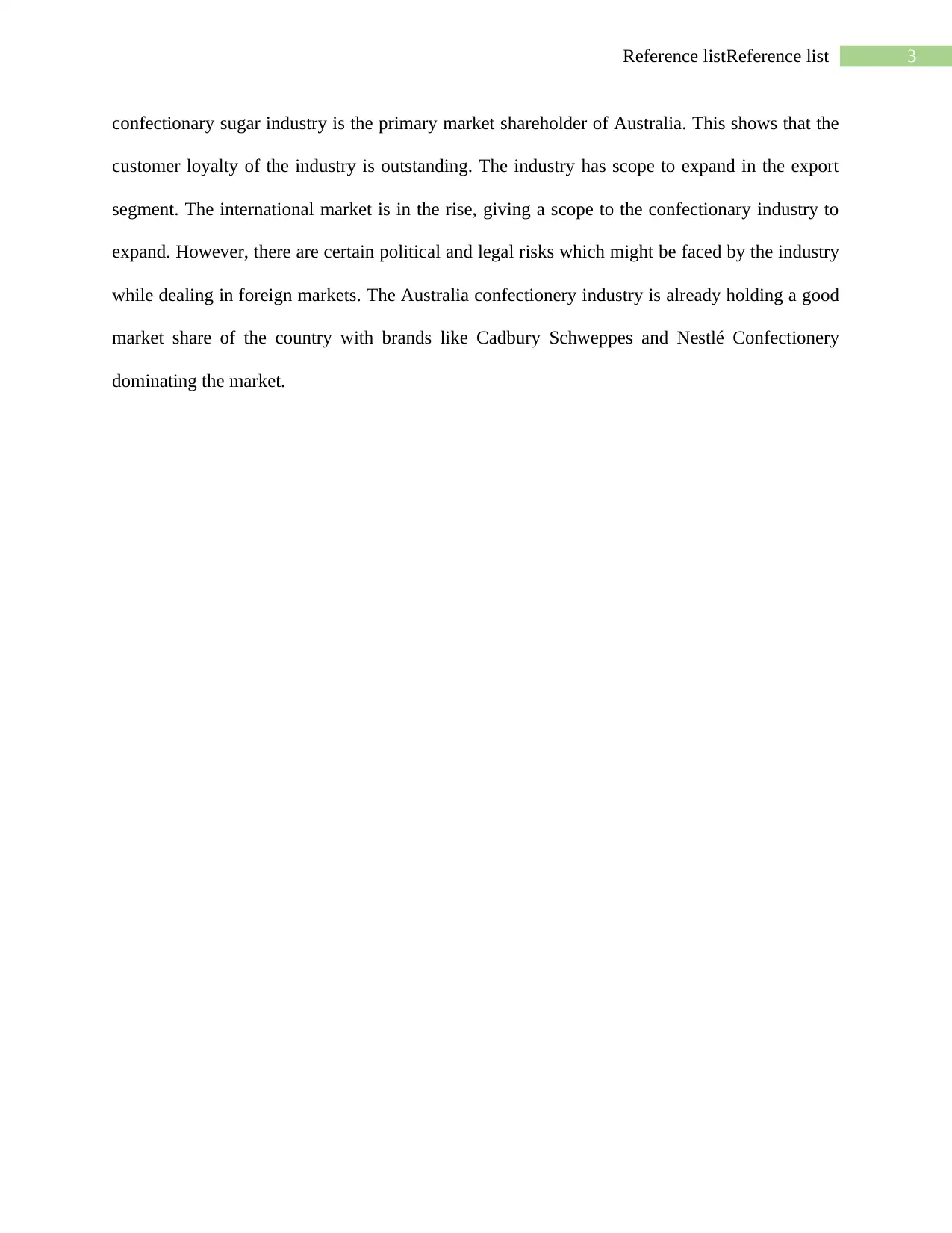
3Reference listReference list
confectionary sugar industry is the primary market shareholder of Australia. This shows that the
customer loyalty of the industry is outstanding. The industry has scope to expand in the export
segment. The international market is in the rise, giving a scope to the confectionary industry to
expand. However, there are certain political and legal risks which might be faced by the industry
while dealing in foreign markets. The Australia confectionery industry is already holding a good
market share of the country with brands like Cadbury Schweppes and Nestlé Confectionery
dominating the market.
confectionary sugar industry is the primary market shareholder of Australia. This shows that the
customer loyalty of the industry is outstanding. The industry has scope to expand in the export
segment. The international market is in the rise, giving a scope to the confectionary industry to
expand. However, there are certain political and legal risks which might be faced by the industry
while dealing in foreign markets. The Australia confectionery industry is already holding a good
market share of the country with brands like Cadbury Schweppes and Nestlé Confectionery
dominating the market.
Paraphrase This Document
Need a fresh take? Get an instant paraphrase of this document with our AI Paraphraser
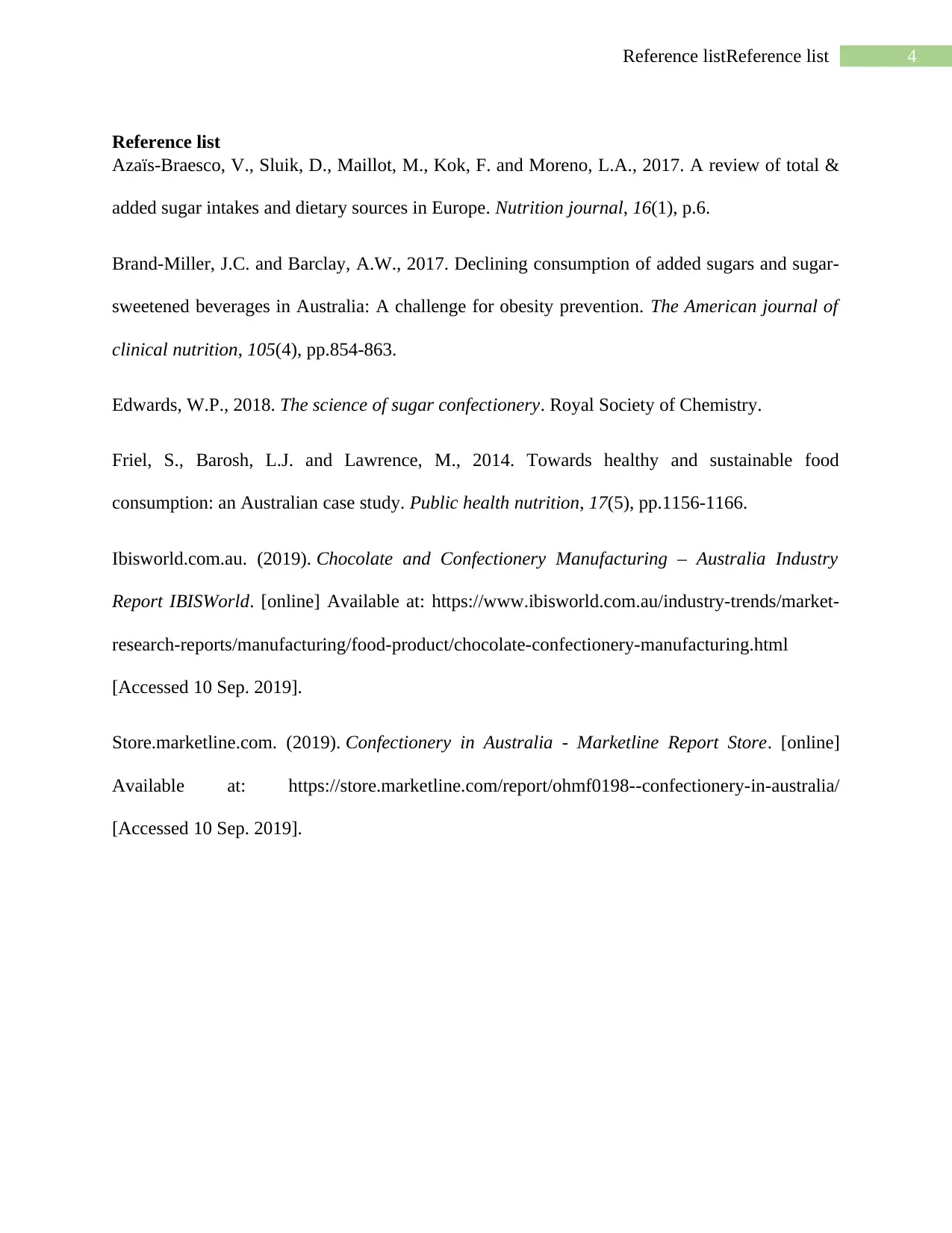
4Reference listReference list
Reference list
Azaïs-Braesco, V., Sluik, D., Maillot, M., Kok, F. and Moreno, L.A., 2017. A review of total &
added sugar intakes and dietary sources in Europe. Nutrition journal, 16(1), p.6.
Brand-Miller, J.C. and Barclay, A.W., 2017. Declining consumption of added sugars and sugar-
sweetened beverages in Australia: A challenge for obesity prevention. The American journal of
clinical nutrition, 105(4), pp.854-863.
Edwards, W.P., 2018. The science of sugar confectionery. Royal Society of Chemistry.
Friel, S., Barosh, L.J. and Lawrence, M., 2014. Towards healthy and sustainable food
consumption: an Australian case study. Public health nutrition, 17(5), pp.1156-1166.
Ibisworld.com.au. (2019). Chocolate and Confectionery Manufacturing – Australia Industry
Report IBISWorld. [online] Available at: https://www.ibisworld.com.au/industry-trends/market-
research-reports/manufacturing/food-product/chocolate-confectionery-manufacturing.html
[Accessed 10 Sep. 2019].
Store.marketline.com. (2019). Confectionery in Australia - Marketline Report Store. [online]
Available at: https://store.marketline.com/report/ohmf0198--confectionery-in-australia/
[Accessed 10 Sep. 2019].
Reference list
Azaïs-Braesco, V., Sluik, D., Maillot, M., Kok, F. and Moreno, L.A., 2017. A review of total &
added sugar intakes and dietary sources in Europe. Nutrition journal, 16(1), p.6.
Brand-Miller, J.C. and Barclay, A.W., 2017. Declining consumption of added sugars and sugar-
sweetened beverages in Australia: A challenge for obesity prevention. The American journal of
clinical nutrition, 105(4), pp.854-863.
Edwards, W.P., 2018. The science of sugar confectionery. Royal Society of Chemistry.
Friel, S., Barosh, L.J. and Lawrence, M., 2014. Towards healthy and sustainable food
consumption: an Australian case study. Public health nutrition, 17(5), pp.1156-1166.
Ibisworld.com.au. (2019). Chocolate and Confectionery Manufacturing – Australia Industry
Report IBISWorld. [online] Available at: https://www.ibisworld.com.au/industry-trends/market-
research-reports/manufacturing/food-product/chocolate-confectionery-manufacturing.html
[Accessed 10 Sep. 2019].
Store.marketline.com. (2019). Confectionery in Australia - Marketline Report Store. [online]
Available at: https://store.marketline.com/report/ohmf0198--confectionery-in-australia/
[Accessed 10 Sep. 2019].
1 out of 5
Related Documents
Your All-in-One AI-Powered Toolkit for Academic Success.
+13062052269
info@desklib.com
Available 24*7 on WhatsApp / Email
![[object Object]](/_next/static/media/star-bottom.7253800d.svg)
Unlock your academic potential
Copyright © 2020–2025 A2Z Services. All Rights Reserved. Developed and managed by ZUCOL.





